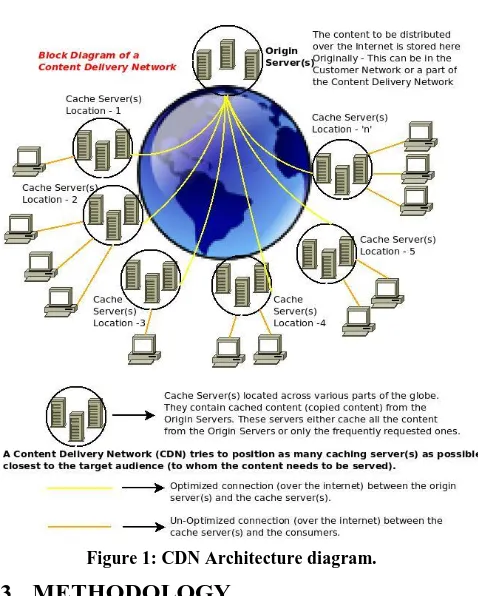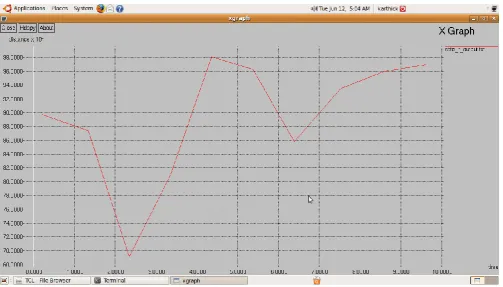Analysing the Media Streaming for QoS in Content
Delivery Networks
Sachin Yadav
Research Scholar
Department of Computer Science & Engineering
UTU, Dehradun (INDIA)
Shailendra Mishra,
PhD.Professor & HOD
Department of Computer Science & Engineering
KEC, Dwarahat (INDIA)
Ranjeeta Yadav
Assistant Professor Department of Electronics & Communication Engineering ABES, Ghaziabad (INDIA)
ABSTRACT
The prediction of performance in CDN (Content Delivery Network) used to improve the technology development. The proposed analysis used how to design a network according to the applications of CDN network experiments with different workloads. This paper shows the variations of any parameter must affect the performance of content delivery network. The Average end-to-end delay, for Quality of service requirements, which are evaluated in this paper and event analysis also, be performed.
Keywords:
Content Delivery Network, AODV, QOS, Routing Protocol.1.
INTRODUCTION
Content Delivery Network consists of many mobile nodes that act as both hosts as well as router in the free space air. Hence Content Delivery Network works without any pre-existing infrastructure. Since the quality of service is big challenge in the field of wireless Content Delivery Networks [1] [2] [3] [4]. Since mobile nodes are plug-n-play devices they have to face many issues in many applications of wireless communications. The field of wireless networking emerges from the integration of personal computing, cellular technology, and the Internet. This is due to the increasing interactions between communication and computing, which are changing information access from “anytime anywhere” into “all the time, everywhere.” At present, a large variety of networks exist, ranging from the well-known infrastructure of cellular networks to non-infrastructure wireless ad hoc networks. When any link of a multi-hop communication path breaks, the path must be repaired or reconstructed. During this period, packets may be dropped. This loss of packets will affect quality of service (QoS) for both real-time and non-real-time applications and cause significant throughput degradation [5] [6]. So, we propose different workload with some parameter variations of the Content Delivery Network to evaluate performance metrics. There are different mobility models are available depends on
routing paths are searched only when needed. A route discovery operation invokes a route-determination procedure. The discovery procedure terminates when either a route has been found or no route is available after examination for all route permutations. In a content delivery network, active routes may be disconnected due to node mobility. Therefore, route maintenance is an important operation of reactive routing protocols. Compared to the proactive routing protocols for content delivery networks, less control overhead is a distinct advantage of the reactive routing protocols. AODV, which is a reactive protocol.
2.1
AODV
The AODV routing protocol supports multi-hop routing among mobile nodes for establishing and maintaining an ad hoc network. AODV uses hop-by-hop routing. AODV is based on the Destination Sequence Distance Vector (DSDV) routing protocol [18]. It borrows the conception of sequence numbers from DSDV, plus the use of the on-demand mechanism of route discovery and route maintenance from DSR. It is called a “pure on-demand route acquisition system”; nodes that do not lie on active paths neither maintain any routing information nor participate in any periodic routing table exchanges. It is loop-free, self-starting, and scales to large numbers of mobile nodes.
2.2
AODV ALGORITHM
AODV operates on a series of request and responses to requests. Node constructing the route to another node sends to all the request (RREQ). The task includes the source and destination IP, the current time according to a source (13) and the time of last known connection, known by the source (17) and the request ID (0xFF). Each node receiving the request 0xFF updates temporary routing table to the source, and:
2.2.1
If previously received a request from the source 0xFF, ignores it.International Journal of Computer Applications (0975 – 8887) Volume 56– No.8, October 2012
2.3.1
Algorithm is nor computationally or memory complex.
2.3.2
Data transfer does not generate additional traffic.2.3.3
Scalable, suitable for mobile networks.
2.3.4
Supports multicasting, tries to minimize the number of required broadcasts.
[image:2.595.54.293.202.500.2]2.4
CDN ARCHITECTURE
Figure 1: CDN Architecture diagram.
3.
METHODOLOGY
This paper proposes the quality of service in AODV mobile ad-hoc networks. The data bytes are changed and the performance where evaluated throughout the networks. The data byte is changed as 500, 1000, 1500 and 2000 respectively. This paper shows how the analysis Content Delivery Networks under these data rates changes. These performances are carried out for small, medium and large scale scenarios. The small scale
scenario was 20 nodes, medium scale scenario 40 and 60 nodes and the large scale scenario 80 and 100 nodes. The simulation was repeated for perfect evaluation
.
4.
PROBLEM STATEMENT
CDN is a difficult task to define and scientific research work. Most important challenges in CDN are to providing quality of service in multimedia. QOS [11] is usually defined as a set of service requirements that needs to be met by the net- work While, transporting a packet stream from a source to its destination.
5.
PROPOSED WORK
Quality of Service [12] refers to the capability of a network to provide better service to selected network traffic over various technologies. This approach is based on a new concept of AODV. Many approaches like DIFFSERV, INTSERV were applied to provide quality of service. The previous example is SHARP, Which have proactive and reactive process according to their size zones network.
6.
RESULT AND DISCUSSION
We implemented CDN approaches within the Network Simulator ns-2 [14]. The topology was created using the GT-ITM topology generation tool with the transit-stub model, having 100 nodes. A video file of 1 minute duration, having a data-rate of 100 Kbit/s was selected for all the simulations.
The below figures show the comparison of proposed QOS with other protocols separately. Other recital metrics with different variations were also calculated and observed. By observing the below results this method delivers high performance compared with the protocols separately.
7.
CONLUSION AND FUTURE WORK
International Journal of Computer Applications (0975 – 8887) Volume 56– No.8, October 2012
[image:4.595.57.549.395.674.2]Figure 3. End To End Delay.
Figure 5. Error-Resilience For Receiver.
8.
REFERENCES
[1] P. Krishnan, D. Raz, and Y. Shavitt, “The Cache Location
Problem,” IEEE/ACM Transaction on Networking, Vol. 8, No. 5, 2000.
[2] L. Qiu, V. N. Padmanabhan, and G. M. Voelker, “On the Placement of Web Server Replicas,” In Proceedings of IEEE INFOCOM, Anchorage, Alaska, USA pp. 1587-1596, April 2001.
[3] S. Jamin, C. Jin, A. R. Kure, D. Raz, and Y. Shavitt, “Constrained Mirror Placement on the Internet,” In Proceedings of IEEE INFOCOM, Anchorage, Alaska, USA, April 2001.
[4] B. Li, M. J. Golin, G. F. Italiano, D. Xin, and K. Sohraby, “On the Optimal Placement of Web Proxies in the Internet,” In Proceedings of IEEE INFOCOM, NY, USA, pp. 1282-1290, March 1999.
[5] Y. Chen, R. H. Katz, and J. D. Kubiatowicz, “Dynamic
Replica Placement for Scalable Content Delivery,” In Proceedings of International Workshop on Peer-to- Peer
Communications, Vol. 21, Issue 6, pp. 979-994, August 2003.
[9] G. Peng, “CDN: Content Distribution Network,” Technical
Report TR-125, Experimental Computer Systems Lab, Department of Computer Science, State University of New York, Stony Brook, NY, 2003.
[10] C. Yoshikawa, B. Chun, P. Eastham, A. Vahdat, T. Anderson, and D. Culler, “Using Smart Clients to Build Scalable Services,” In Proceedings of USENIX.
[11] 3GPP technical Specification Group Services and System Aspects, “QoS Concept and Architecture”, Release 1999, March 2000.
[12] R. Chowdhury, P. Bhandarker, M. Parashar, “Adaptive
QoS Management for Collaboration in Heterogeneous Environments”, Proc. IPDPS Heterogeneous Computing Workshop, pp. 234-255, Florida, April 2002.
[13] N. Semret, R. Liao, A.T. Campbell, A.A.Lazar, “Peering



